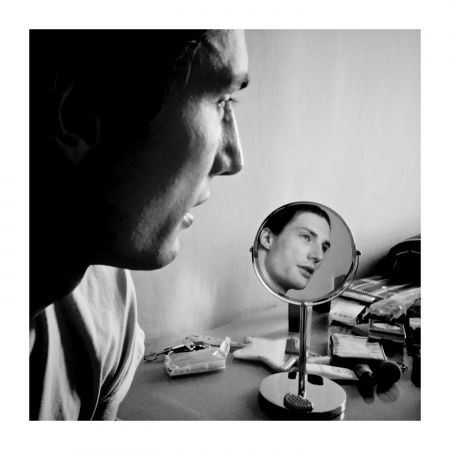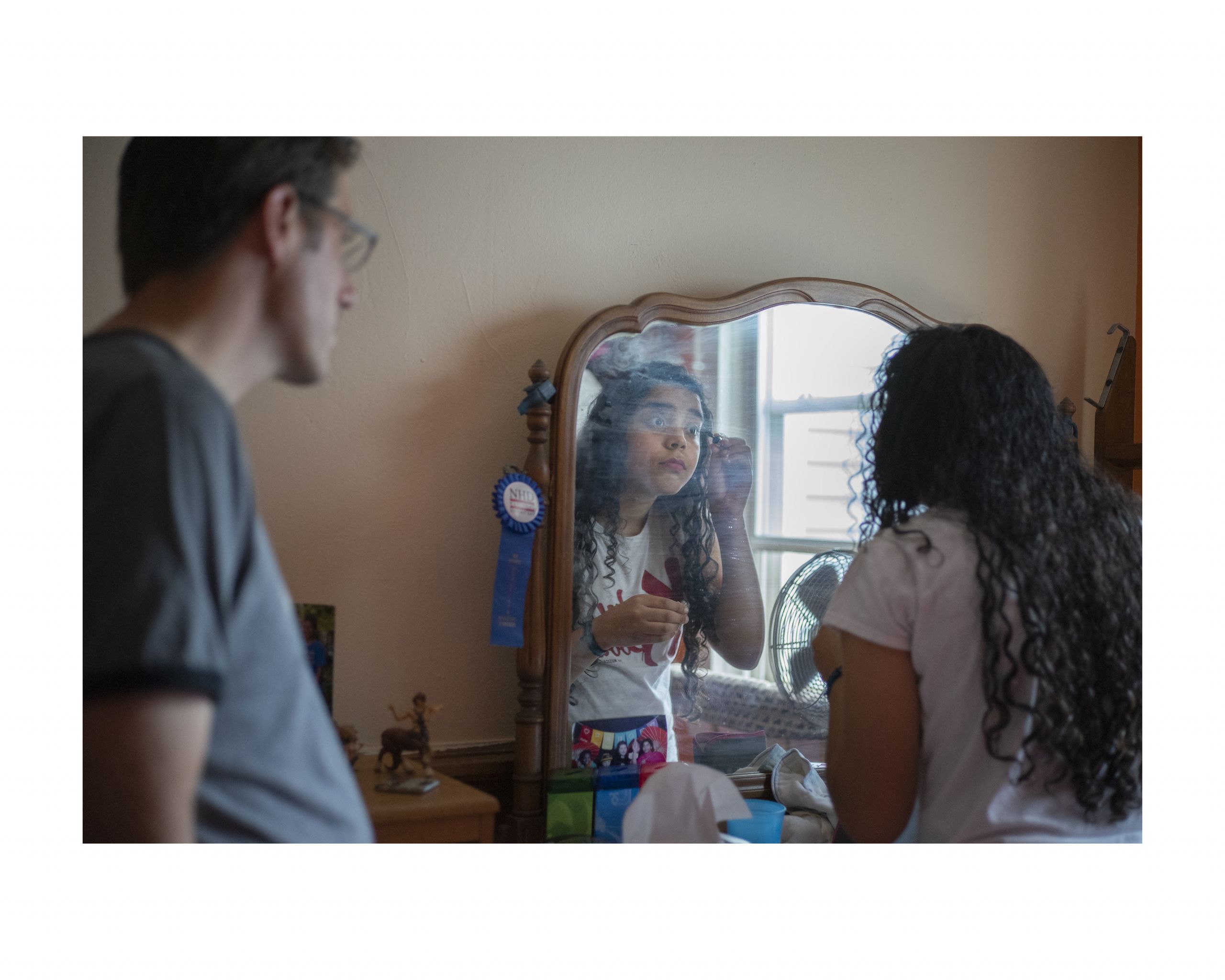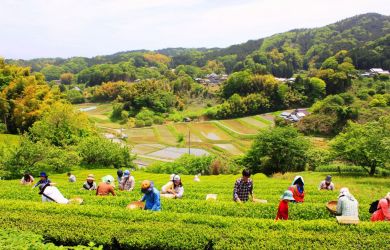
August 25, 2020
Embracing Transgender and Gender Nonconformity
Photographer Paule Saviano returns to Tokyo with crucial new exhibition
By Paul McInnes
Brooklyn-based photographer Paule Saviano has had an incredible career, from being on the road with bands like The Cure and The Smashing Pumpkins to photographing hibakusha (a survivor of either of the atomic bomb attacks on Hiroshima and Nagasaki) and burlesque dancers. His latest exhibition, “Embrace” at Gallery éf in Asakusa (September 2 – October 25), is a stunning photographic exploration featuring a large collection of portraits of transgender youth, adults and elderly. “Embrace” demonstrates the immensely diverse range of identities and experiences of transgender, intersex and gender nonbinary people. The portraits illustrate how people with gender identities outside of the traditional categories are not confined to one country, culture, age or group. Metropolis picked Saviano’s brain in a recent interview about his latest ground-breaking project and artistic philosophy.
Metropolis: What initially drew you to an ongoing project about transgender and gender nonconforming people?
Paule Saviano: I began photographing transgender and gender nonbinary people in 2016 and titled the project “Embrace.” That summer there was an increasingly visible debate in America about civil rights for transgender and gender nonbinary people, focusing especially on young transgender students. I have known transgender adults all my life but I had never given thought to when a transgender person realizes that the gender they identify with is different from the body they were born in. I was curious to find out when a transgender person would begin to transition to the gender they identify with and what that transition was like emotionally. I think many people concentrate on the physical aspects of transitioning, but I’m interested in the emotional part of it – the emotional process has to be fiercely intense.
The transgender and gender nonconforming community in Japan often live in secret or face discrimination. — Paule Saviano
Every time I pick up a camera it’s for the purpose of learning. I approached photographing transgender and gender nonbinary people as an outsider. I’m not transgender or part of the LGBTQ+ community, even though growing up in New York City I have been around the community all my life and I am an advocate for the community’s rights.
I photographed transgender and gender nonbinary people from America, the Netherlands, the Czech Republic and Scotland. These societies have different views about gender identity. The Netherlands is the most progressive society and has shown more openness compared to a country like the Czech Republic, which is still deeply rooted in traditional ideas of gender. As a result, the people I photographed in the Netherlands were younger because they were allowed to transition without being shamed or discriminated against.
I chose the people I photographed to demonstrate diversity in race, age, religion, economic situation and geographical location. The youngest person I photographed was five years old and the eldest 72 years old. In America, I tried to highlight the experiences of transgender people of color and transgender people who are religious. It was important to show that transgender and gender nonbinary people weren’t confined to just one demographic. They are present in all societies and cultures.
My goal is to photograph each person over a 15 to 20 year period to create a visual voice that documents their transition. It will be interesting, especially with the kids, to see how they navigate the journey over a long period of time.

I don’t have a set gender identity.
I used to have a strict female and male persona.
But now I think the boundaries are getting blurred.
— Radovan
M: You’re more known as a music and historical photographer. How much of a departure is this work from previous projects?
PS: At the beginning of my career, during the late 1990s, I mostly photographed musicians, then moved onto photographing editorial fashion in the early 2000s. In 2007, the first project I ever exhibited was a portrait project about burlesque performers called “Striptease Burlesque.” It was shown and curated by Izumi-san at Gallery éf in Asakusa, Tokyo and then brought to Shanghai and Helsinki.
It wasn’t until 2008 when I began photographing “From Above,” which is a long term project featuring portraits and testimonies of atomic bomb survivors and firebombing survivors from World War II. The difference with “Embrace” is that it will be like a narrative since I’m photographing the same people transitioning over a long period of time.
The subject matter I’ve chosen to photograph during the past decade is obviously much more serious than when I began my career. I’ve probably changed, and hopefully matured, as a person since then. But the focus of my photography has always been the person in front of my camera. Whether it’s a musician, an atomic bomb survivor or a transgender kid, my goal is to give that person a voice and to capture an emotion. I want the photograph to be about them and not the photographer.
I have a responsibility to photograph subjects I feel strongly about and want to learn more about. My portraiture concentrates on people who have been shaped by an event or circumstance that has left its impression on them and defined their life. I’m also committed to documenting the lives of people that society marginalizes. It’s my desire as an artist to confront aspects of our society that people would rather ignore.
Photography is subjective so it will help document the time for some people but not for everyone. — Paule Saviano
M: JK Rowling has attracted a lot of criticism on social media for her view on transgender/nonconforming people. What are your views on this and how these people are viewed in general?
PS: I try not to pay attention to what others are saying because I don’t want to divert attention from what I can do. JK Rowling’s words have an impact on many people and it’s dangerous when someone of her stature has an opinion that is harmful to others. With the use of social media it’s easy for people to declare their opinions as facts, when we all should know that opinions are not facts, they are just opinions. The world is currently in an abyss because opinion is now being accepted as fact.
M: There has been a recent wave of people being misgendered (using the wrong or inappropriate pronouns) on social media posts and mainstream media. Where do you stand on this?
PS: A simple answer: we should respect everyone enough not to misgender them. Most of the time the misgendering is done on purpose to be demeaning. When done on purpose, that’s just disrespectful and classless.
The biggest problem is misinformation, not only being spread through social media and the media but also by elected officials and governments. Informing the public of the facts about what it means to be transgender or gender nonbinary will be beneficial to remove the stigmas and false perceptions that lead to the discrimination and outcasting of transgender people from society.
Another misconception is that people will say that transgender and gender nonconforming people are confused, that they don’t understand and that they don’t know who they are. And I think there’s a problem when you say that. Most of these people who I’ve photographed have understood at a young age that they identify as a different gender than they were assigned at birth, and they can clearly articulate that. I also feel it’s problematic that the traditional viewpoints of gender are ingrained in all societies, it’s important not to assign stereotypical behavior and characteristics to gender identities.
Everything starts with education and information. The lack of understanding is always the easiest path to prejudice, so if we understood a little bit more about what transgender and gender nonconformity is, it would go a long way. I hope that someone can see my photographs and learn about their struggles and the fact that they just want to live a happy, productive life, just like anybody else. They’re not threatening anybody else’s survival or lifestyle, they’re just looking to be recognised and to be part of a society that accepts them. Transgender people are not asking for anything special; they desire to be afforded the same rights that everyone else is afforded.
Elsewhere on Metropolis
- New Documentary Highlights Trans Youth in Japan
- At the Forefront: Conversations with a Black Trans Activist
- Paule Saviano: From Above
- Paper Cities: Untold Stories from the Firebombing of Tokyo
M: You have traveled all over the world for this project. What have you learned from this experience?
PS: As I photographed, I’ve realized that everyone’s experience was distinct, and the culture they lived in influenced how difficult it was. While many societies are reevaluating how they understand and represent gender, others are steadfastly intolerant and reactionary.
My impression is that transgender people who transition to the gender they identify with, in a supportive and well-informed environment, have a healthier and more productive life. Transgender people who live in cultures, like in the Netherlands, which offer counseling and medical treatment at young ages will benefit physically and emotionally.
I entered this experience with an open mind. But it took time to realize that the traditional viewpoints of gender are very rooted, even in myself. The project began when I photographed a five-year-old transgender boy named Bryan. He was dressed in a navy blue suit, a dapper bow tie and only spoke about superheroes. My instinct was because Bryan dressed in a blue suit, had short hair and spoke about boyish interests, that it was simple: Bryan was a boy.
As I met more transgender and gender nonbinary people it was evident this was contradictory because I was reinforcing gender stereotypes, even without realizing it. I had photographed transgender girls who still intensely followed sports they were interested in prior to their transition. Emphasizing gender stereotypes, in order to validate transgender and gender nonbinary people, is precarious. They do not need to succumb as a stereotypical male or female to be accepted in society as the gender they identify with. Gender is so much more complex than the “shortcuts” of societal norms like dress, hobbies etc. And it’s crucial to remember that when talking about transgender identities as well.

— Tavish
M: What is the current situation with your other project about atomic bomb survivors and victims of war?
PS: “From Above” is permanently exhibited at the Nagasaki National Peace Memorial Hall for Atomic Bomb Victims in the Nagasaki Atomic Bomb Museum. It also continues to be exhibited in different parts of the world. It’s scheduled to be exhibited in Dresden, Germany this autumn and was shown at Gallery éf in Tokyo in March 2018. Gallery éf has been my partner in the project since its inception so the project will hopefully continue to be shown there frequently.
I was recently working in Nagasaki and in Rotterdam photographing portraits of World War II firebombing survivors which expanded from the firebombing portraits I had already photographed in Tokyo, Dresden, Coventry and Wielun. I’m determined to photograph survivors of Nagasaki and Hiroshima until the final voice goes silent. The education I have received from every survivor I have met is too important for me to say,“That’s enough…”
M: How can photography document everything that has happened in 2020?
PS: I don’t think we can answer that question yet because we’re still in the moment and in the midst of this crazy period of time. Wherever this unsettling journey takes us, photography will play a part in documenting the emotions of what we are experiencing. It has been a difficult time because of the uncertainty of multiple crises. The COVID-19 pandemic threw a thick layer of complexity onto an already chaotic world. It seems like we have been dealing with ongoing issues of racial and gender inequality, refugee crises, the rise of incompetent leadership which threatens our civil liberties with polarizing politics, climate change, war and other issues for decades.
Photography is subjective so it will help document the time for some people but not for everyone.

M: Are you a humanist? How would you describe your personal philosophy?
PS: I’m not into labels. I believe that we all have the right and responsibility to give meaning and shape to our lives. And that we can be motivated by compassion to make a better world.
Life and what I photograph is guided by my heart. It’s not an efficient way to go through life, but it’s the path I follow. Most of the subjects I’ve photographed have been because of a deep curiosity to learn more. I believe this is what allows me to photograph a subject over many years. The day I don’t feel totally invested in what I’m doing is the day I find something else to do.
M: Why should Metropolis readers attend your exhibition at éf Gallery?
PS: When the audience views my photographs, I hope it makes them think deeply about the subject and that “Embrace” puts a face to: what it’s like being transgender or gender nonbinary.
The transgender and gender nonconforming community in Japan often live in secret or face discrimination. My hope is that Japan will begin to make the necessary changes that other countries have enacted to educate its society about people living outside the traditional categories of gender, and modify its legal system to make it easier to transition to the gender a person identifies with.
No one should have to seek a politician’s, judge’s or the majority’s stamp of approval to live the lifestyle they desire. People with gender identities outside of the traditional categories shouldn’t have to live on the outskirts of a society that doesn’t care if they live or die. Through education and awareness, it is possible for everyone to feel safe, recognized and respected.
“Embrace” at Gallery éf from September 2-October 25
Gallery: 12pm-6pm
Cafe: 11am-6pm
Bar: 6pm-12:30am
(Closed every Tuesday)
Gallery éf: 2-19-18 Kaminarimon, Taito-ku
gallery-ef.com







